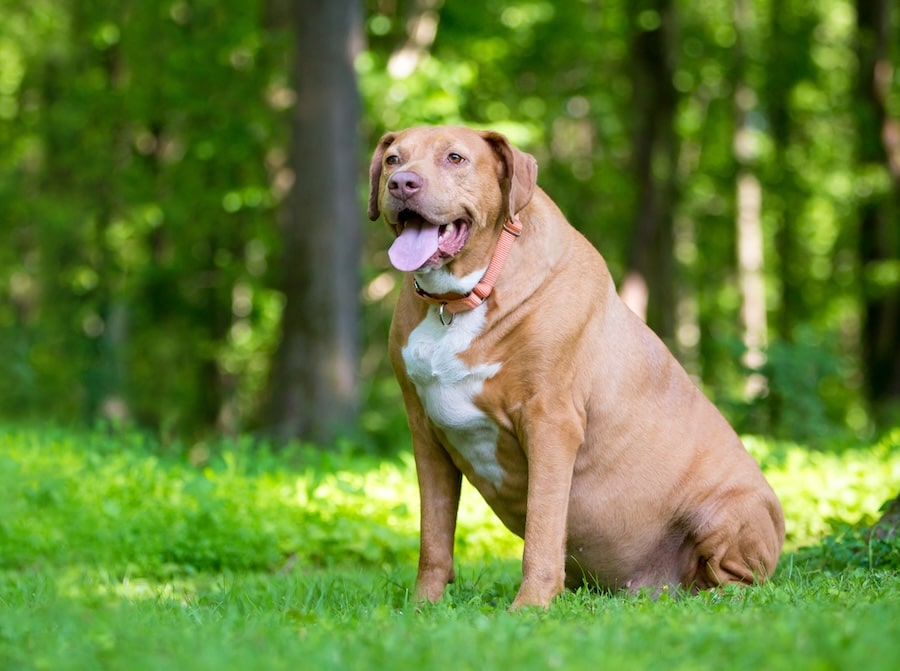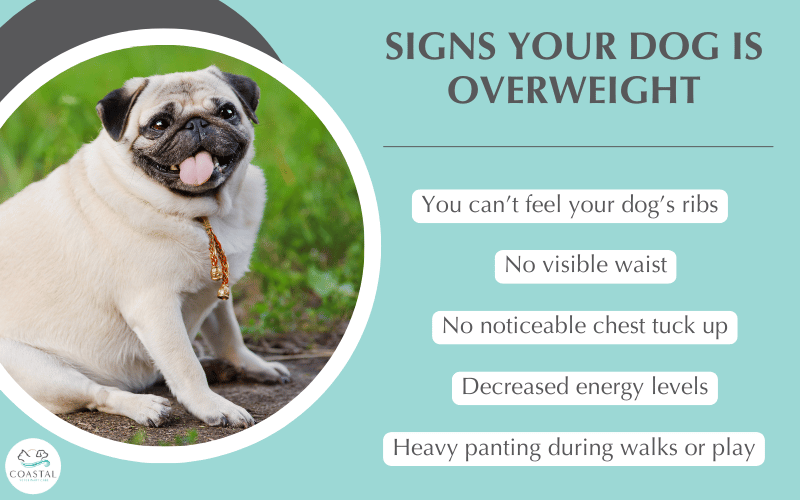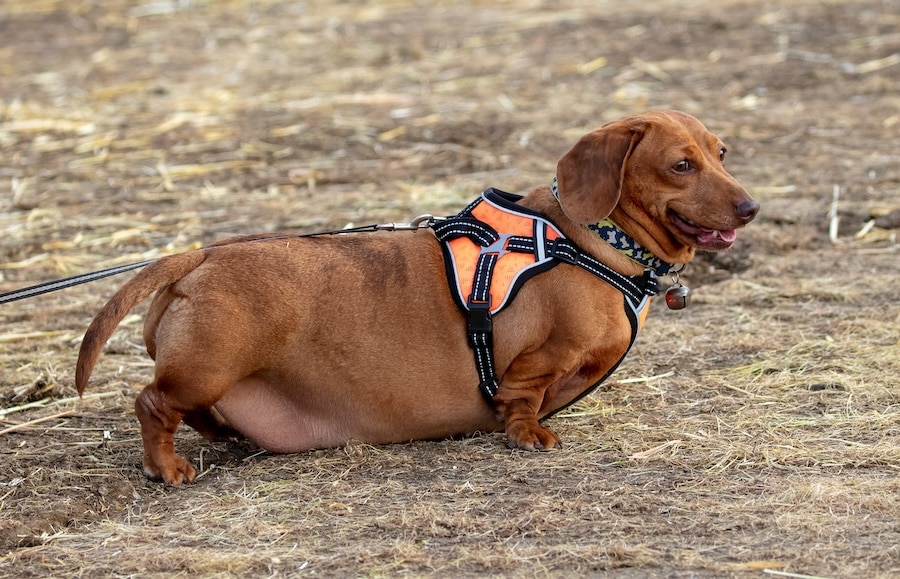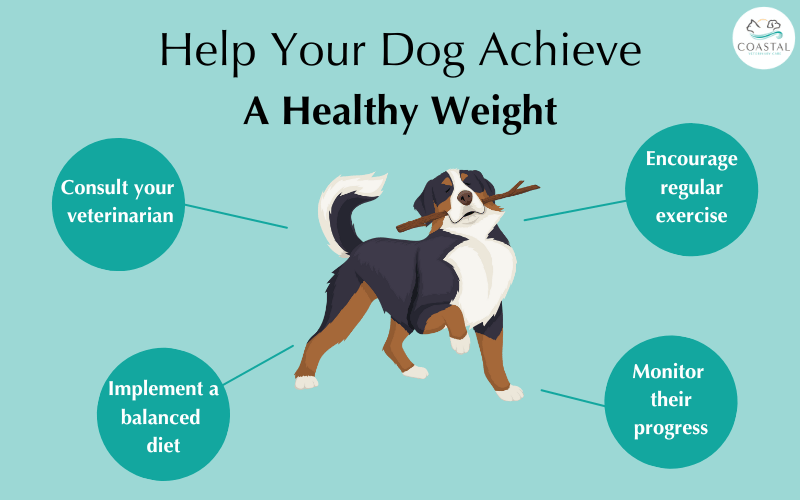Dog obesity is a common issue that many pet parents don’t recognize, often mistaking excess weight for a sign of good health. If you can’t easily feel your dog’s ribs or notice a lack of a visible waistline, they may be carrying extra weight. Just like humans, dogs need a balance of healthy eating and regular exercise, but since they rely on us for their care, it’s up to pet owners to make the right choices to keep them at an ideal weight and prevent serious health issues.
Understanding the Importance of a Healthy Weight
Pet obesity is a growing concern in the United States, with studies showing that over half of all dogs in the U.S. are classified as overweight or obese. Many pet parents may not realize their dog is carrying extra weight, which can significantly impact their health and longevity. Maintaining a healthy weight is essential for preventing various painful conditions and ensuring your pet enjoys a high quality of life.
Potential Health Issues
Excess weight puts undue strain on a dog’s body, leading to a higher risk of joint pain, difficulty breathing, and heart disease. Overweight dogs are also more likely to develop diabetes, as increased body fat can cause insulin resistance, making it harder for their bodies to regulate blood sugar levels. Additionally, obesity contributes to painful conditions such as arthritis, reducing mobility and making exercise more difficult.
Another critical concern is that overweight dogs often have a shorter lifespan than those who maintain their ideal weight. Carrying extra pounds places strain on vital organs, which can lead to health issues that diminish both the length and quality of life. Pet obesity prevention starts with early recognition and action, including regular check-ups and twice-yearly wellness exams to monitor a pet’s weight and overall health.
By proactively managing your pet’s weight through dietary adjustments, portion control, and an exercise plan, you can help prevent these health issues and provide your furry friend with a healthier, happier life.
Identifying Signs Your Dog is Overweight
Recognizing whether your furry friend is carrying extra weight is essential for their long-term health. While some weight fluctuations are normal, consistent weight gain can indicate that your pet is developing an issue with obesity. Here are some key physical and behavioral signs that your dog may be overweight:
Physical Examination
Rib Check
One of the simplest ways to assess your dog’s weight is by feeling their ribs. Ideally, you should be able to feel your pup’s ribs without pressing too hard. If a thick layer of fat prevents you from easily detecting them, your dog may be overweight.
Waistline Observation
When viewed from above, your dog should have a visible waistline that curves inward before the hips. If your dog’s body appears more oval-shaped or lacks definition between the ribs and hips, they may be carrying excess weight.
Abdominal Tuck
When viewed from the side, your dog should have a noticeable tuck-up, meaning the area behind the dog’s chest should rise slightly toward the hind legs. If their belly hangs lower or appears rounded, it could be a sign of weight problems.
Behavioral Indicators
Decreased Energy Levels
An overweight dog may show less enthusiasm for exercise, preferring to lie down or take frequent breaks during walks. They might also be reluctant to engage in activities they once enjoyed.
Heavy Panting During Walks or Play
If your dog struggles to keep up with their normal routine, pants excessively, or experiences difficulty breathing after short periods of exertion, their extra pounds may be putting strain on their heart and lungs.
Identifying these signs early can help prevent further complications and allow for proactive steps, such as dietary adjustments, a strict exercise schedule, and routine wellness exams to track your dog’s progress. If you notice these symptoms, a vet consultation can help develop a weight loss plan tailored to your pet’s needs.
Utilizing the Body Condition Score (BCS) System
The Body Condition Score (BCS) system is a reliable tool used by veterinarians to assess a dog’s weight and overall body fat. Developed by experts, including the American Animal Hospital Association (AAHA) and Pet Obesity Prevention, this system helps pet parents determine whether their canine companion is underweight, at an ideal weight, or overweight.
The BCS scale ranges from 1 to 9:
- 1-3 – Underweight: Pup’s ribs, spine, and hip bones are visible with little fat covering.
- 4-5 – Ideal weight: Dog’s ribs can be easily felt with a visible waistline and noticeable tuck-up.
- 6-7 – Overweight: Extra fat covers the dog’s ribs, waistline is less defined, and the body appears rounded.
- 8-9 – Obese: Excess fat deposits, no visible waistline, and difficulty moving due to extra pounds.
Steps to Achieve and Maintain Your Dog’s Ideal Weight
Maintaining a healthy weight is essential for your canine companion’s well-being. Following these key steps can help manage weight gain, prevent health issues, and promote a longer, more active life.
Consult Your Veterinarian
Schedule a thorough examination
- A vet visit can rule out any underlying illness contributing to weight gain.
- A thorough examination helps determine if other health issues, like joint pain or metabolic conditions, are affecting your dog’s weight.
Develop a personalized weight loss plan
- Your vet will recommend dietary adjustments and an exercise plan tailored to your dog’s needs.
- Consider switching to low-calorie diet food to reduce extra calories while maintaining proper nutrition.
Implement a Balanced Diet
Choose the right portion sizes
- Feeding guidelines on food packaging can be misleading—consult your vet to determine the correct amount.
- Measure meals carefully to prevent overfeeding.
Avoid unnecessary extra calories
- Minimize treats and avoid feeding table scraps that add extra weight.
- Opt for healthy, low-calorie treats to reward good behavior.
Encourage Regular Exercise
Establish a strict exercise schedule
- Plan daily physical activity suited to your dog’s breed and fitness level.
- Aim for at least 30 minutes of exercise per day, including walks, swimming, or agility training.
Make being active fun for your dog
- Play fetch or tug-of-war to keep your pet moving.
- Interactive toys and food puzzles can also promote movement.
Monitor Progress
Conduct regular weigh-ins
- Track your pet’s progress by weighing them weekly.
- Assess changes using the Body Condition Score (BCS) to ensure steady improvement.
Schedule follow-up appointments
- Your vet may adjust the weight loss plan based on your dog’s progress.
- Routine wellness exams and regular weigh-ins help ensure long-term success.
By following these steps and making gradual adjustments, you can help your pet reach and maintain their ideal weight, improving their overall health and strengthening your closer bond with them.
Why Coastal Veterinary Care?
At Coastal Veterinary Care, we help pet parents manage their pet’s health, including maintaining a healthy weight. Our experienced vet team provides compassionate care and expert guidance to keep your pet in optimal condition.
Comprehensive Veterinary Services
We offer a full range of services, including preventive care, dentistry, dermatology, which includes digital cytology, wellness exams for cats and dogs, end-of-life care, urgent care, an in-house pharmacy and more. Our vet team focuses on early detection, treating underlying illnesses, and providing dietary adjustments and exercise plans to support long-term health.
Expert Veterinary Team
Our fear-free certified staff creates a stress-free experience while educating pet parents on maintaining their pet’s ideal weight and overall well-being. We take a personalized approach to help pets avoid weight gain, painful conditions, and health issues.
At Coastal Veterinary Care, we are committed to helping pets live long, happy, and healthy lives through expert veterinary care and support. Contact us today to schedule an appointment!
Resources:
https://vcahospitals.com/know-your-pet/heart-disease-in-dogs
https://www.akc.org/expert-advice/health/diabetes-in-dogs/
https://wsava.org/wp-content/uploads/2020/01/Body-Condition-Score-Dog.pdf





